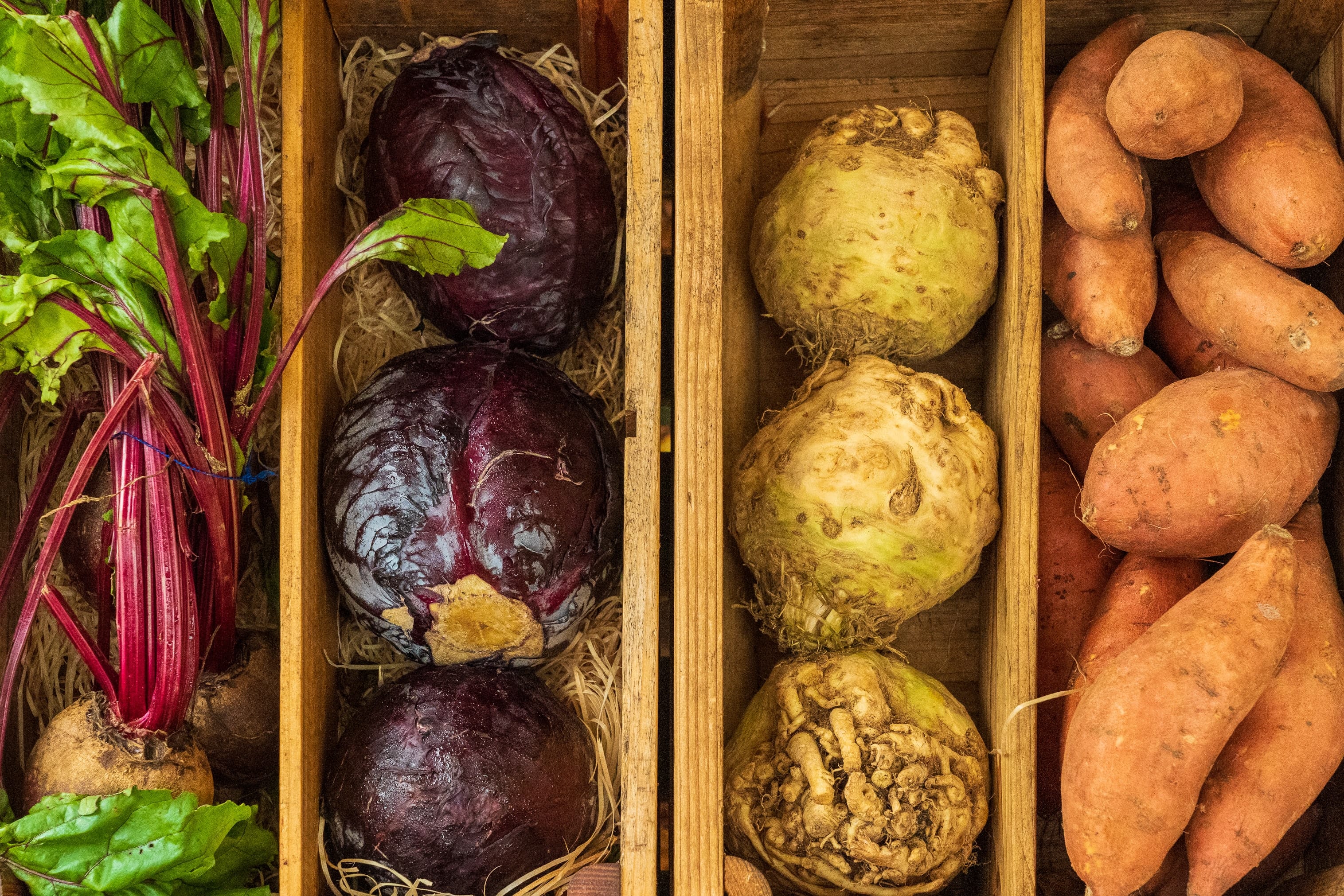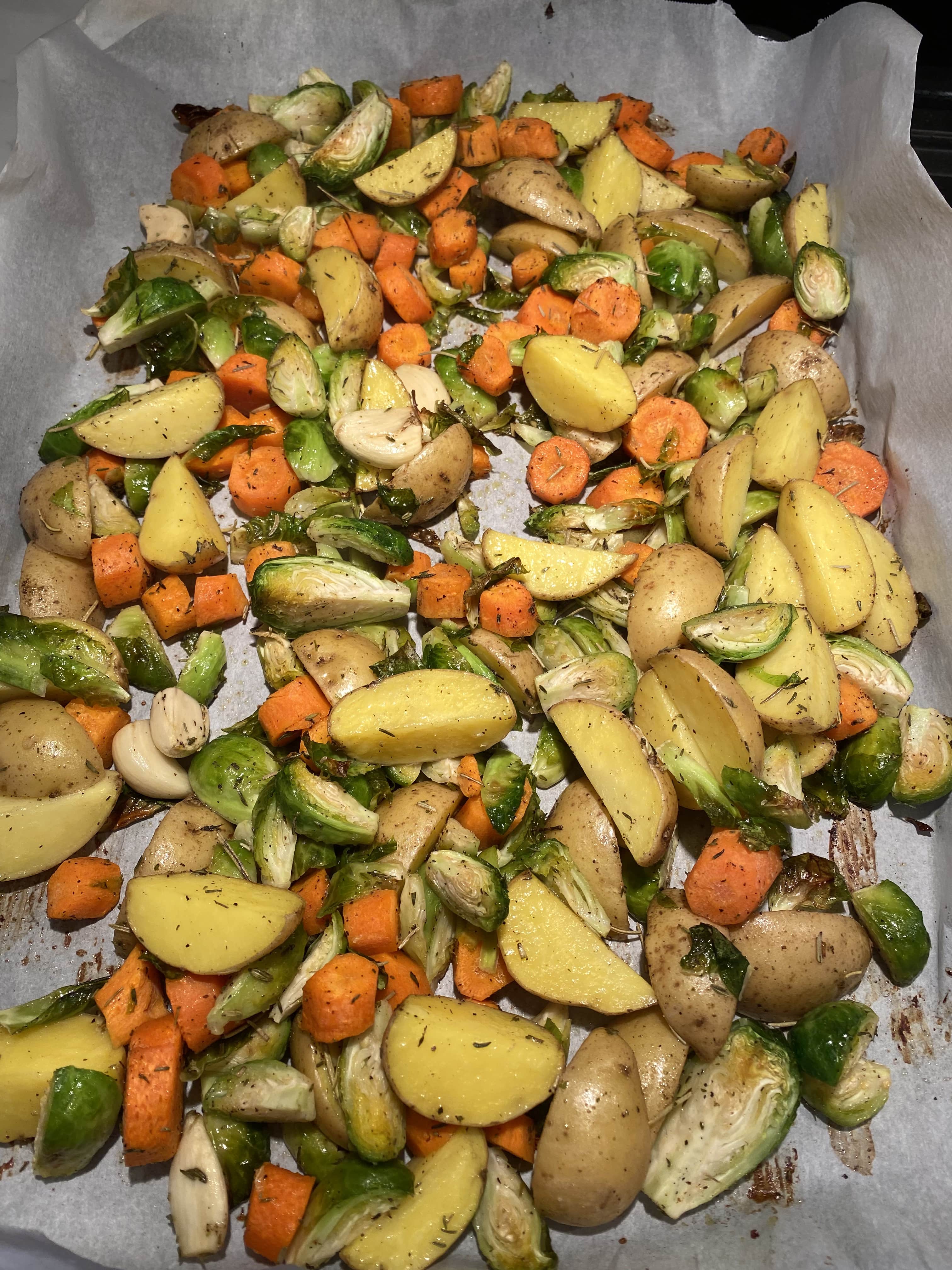When you think of winter, what comes to mind? Cozy days curled up with a good book and a hot beverage, and hearty stews and soups are some of our favorite cold-weather rituals. And while we love the spring and summer seasons for their vibrant, fresh produce, winter veggies have a place in the spotlight as well.
Amber Worst, our registered dietitian, has shared some her favorite winter recipes packed with hearty, nutritious veggies that are easy to make at home.
Sheet Pan Roasted Winter Vegetables
A lot of winter veggies are hearty veggies, like purple and green cabbage, sweet potatoes, squash, carrots, beets, and onions. When choosing carrots and sweet potatoes, you not only are getting a lot of dietary fiber — which is important for our diet to help lower cholesterol levels, reduce risk of heart disease, and help regulate blood sugar levels — but you're also getting other nutrients, such as beta carotene and vitamin A, which help improve night vision and protects your skin from sun damage.
Some grocery shopping considerations: Bagged “baby” carrots may be more convenient; however, baby carrots are not baby at all. They are mature carrots that are milled down to a small size, then soaked in a water solution. So although they're convenient, baby carrots don't have as much flavor as the ones you can prep yourself.
Onions add a range of flavors and essential nutrients to many dishes. They range from large yellow, white, and red onions to sweet varieties, such as Vidalia onions. Nutritionally, onions can help boost immunity and have been proven to have cancer-fighting antioxidants called flavonoids.
My favorite way to prepare winter vegetables is to choose two or three of them, chop them all about the same size, and put some olive oil and salt on them.
Then, I place them all on a sheet pan and roast them in the oven at 425 degrees F. I bake the veggies for about 25 to 35 minutes. By roasting them, the vegetables often form a crust that helps them retain their natural juices and nutrients — all while getting very flavorful results.
Sautéed Cabbage
Sautéed cabbage is an easy side dish. Cabbage is nutritionally rich and throughout history has been both a medicine and a food. Along with broccoli and Brussels sprouts, cabbage is a cruciferous vegetable with cancer-fighting properties. And it's low in calories and high in fiber.
When selecting a head of cabbage, choose one that is firm, feels heavy for its size, and make sure it has some glossiness to it. To prepare, discard any wilted outer leaves and rinse. Then, chop the cabbage up. Heat a large sauté pan or similar heavy-bottomed pot over medium-high heat. Add olive oil to the pan.
Once the oil is shimmering, add the cabbage and salt. Sauté for 10 to 15 minutes, stirring occasionally, until the cabbage is tender and begins to brown. Don't feel like you have to constantly stir it — leaving cabbage undisturbed for a minute or two will allow it to develop brown caramelized bits (and give you delicious flavor).
Easy Cabbage Casserole
Another way to prepare cabbage is by making a simple cabbage casserole. This is a comfort food recipe that was passed down to me from my aunt. It reminds me of snuggling up on a cold winter's day, grabbing a bowl, and playing games with family.
—1 1/2 pounds ground beef
— 2 medium onions, finely chopped
— 1 clove garlic, minced
— 1 teaspoon salt
— 1/4 teaspoon black pepper
— 1 can (7.5 ounces) of tomato sauce
— 1 cup of water
— 1 can of tomato soup
— 1/2 cup long grain rice, uncooked
— 4 cups shredded cabbage
— 1/3 cup of tomato juice
In a large skillet, combined beef, onion, garlic, salt, and pepper. Cook stirring until beef is no longer pink. Drain off the grease. Add tomato sauce, water, and half of the tomato soup. Mix well then stir in the rice.
In a crockpot, place half the meat mixture and then half the shredded cabbage on top. Repeat the layers. In a bowl, combine the remaining tomato soup with tomato juice until blended. Drizzle over the top layer of cabbage in the crockpot. Cover the crockpot and cook on low for 8–10 hours or on high for 4–6 hours. Serve hot.
We hope these recipes will help you find new and exciting ways to incorporate more veggies to your diet during the winter months.
At OnSite Wellness, health and wellness is our specialty. Incorporating a wellness program at your workplace can have massive benefits for your employees in managing their health. Contact us to learn more!
-1.png?width=300&name=1127895_OSW%20Tagline%20Logo_081021%20(1)-1.png)



